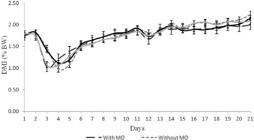ABSTRACT:
Additives are used in high concentrate diets to prevent metabolic disorders in cattle. This study was designed to evaluate the effect of calcium sources and monensin on the control of ruminal acidosis in Nellore cattle that were abruptly shifted to a high (92.3%) concentrate diet. Eight cannulated steers were randomly assigned to two contemporary 4x4 Latin square. Treatments involved the addition of a calcium source, either limestone (LI) or a product derived from calcareous algae (CA), to the basic diet with or without the presence of monensin. Calcareous alga (Lithothamnium calcareum) is a natural and renewable product and a source of calcium carbonate. The quantity of added limestone, calcareous algae and monensin was 7.1g kg-1, 7.4g kg-1 and 30mg kg-1 DM, respectively. There was no effect of calcium source (P=0.607) or monensin (P=0.294) on feed intake or on the concentration of short chain fatty acids. Treatments with calcareous algae resulted in a higher mean ruminal pH (P=0.039), a shorter amount of time with the ruminal pH under 5.2 (P<0.001) and a better control of blood pH (P=0.006). Treatments with monensin also resulted in a shorter amount of time with the ruminal pH below 5.2 (P=0.023). Calcareous algae were shown to be effective in controlling adverse changes in the rumen and in blood variables for Nellore cattle that were subjected to an abrupt change to a high concentrate diet.
Key words:
acidosis; feedlot; high concentrate; ruminal variables

 Thumbnail
Thumbnail




